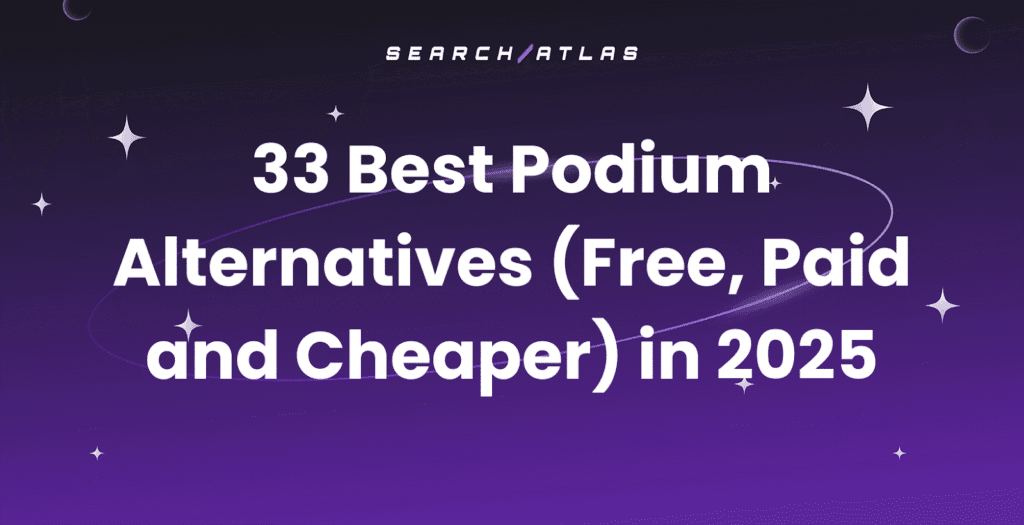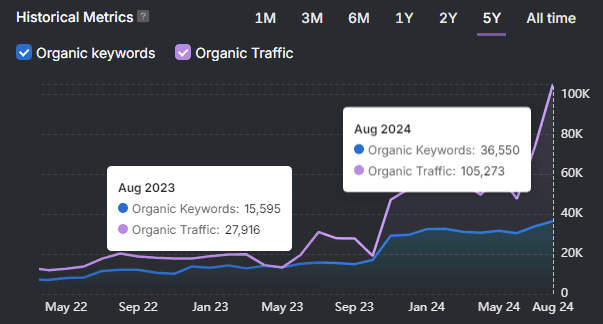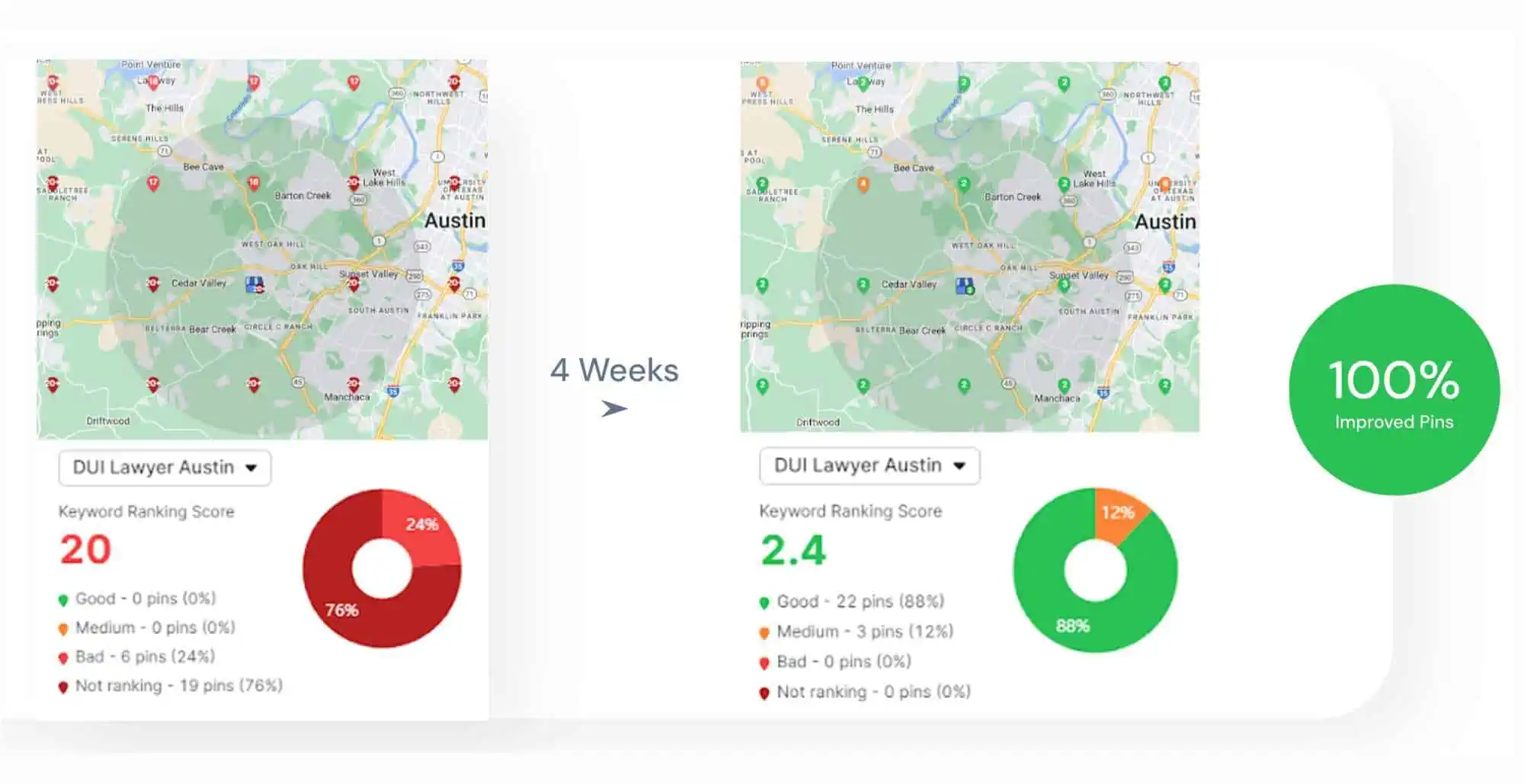Google PageRank is a foundational algorithm that measures webpage importance based on the quality and quantity of incoming links. Developed by Google co-founders Larry Page and Sergey Brin in 1996, the PageRank algorithm interprets links as votes, with links from high-authority websites carrying more weight than those from low-authority websites. While Google no longer publicly displays PageRank scores, PageRank continues to influence search rankings as one of hundreds of factors in Google’s search algorithm.
The importance of PageRank for SEO lies in its ability to establish website authority and credibility through external validation. Understanding how PageRank works and implementing strategies to improve it boosts your site’s overall visibility and performance in search results. Building quality backlinks and optimizing your internal linking structure increases your site’s PageRank and improves your chances of ranking higher for relevant keywords.
What is Google PageRank (PR)?
Google PageRank (PR) is a link analysis algorithm that evaluates the importance of web pages based on their link structure, treating each link as a vote of confidence from one page to another. PageRank assigns a numerical value to every webpage in Google’s index, reflecting its relative importance on the web. Pages with more high-quality backlinks are considered more important and receive a higher PageRank score.
PageRank was named after the term “web page’’ and Larry Page, Google’s co-founder. The PageRank algorithm works by distributing “link equity” (sometimes called “link juice” by SEOs) across the web, with each page passing a portion of its authority to the pages it links to.
The PageRank algorithm formed the foundation of Google’s original search ranking system, revolutionizing how search engines determined content relevance and authority. Unlike previous search engines that relied primarily on on-page factors, Google’s use of PageRank allowed it to use the web’s natural linking structure as a form of democratic voting, where each link served as an endorsement.
Originally, Google displayed PageRank publicly on a scale of 0-10 (PR0 to PR10) through the Google Toolbar, but this practice was discontinued by Google in 2016.
What is the History of Google PageRank?
The history of Google PageRank begins at Stanford University, where Larry Page and Sergey Brin developed the algorithm as part of a research project in 1996. In 1998, Page and Brin published “The Anatomy of a Large-Scale Hypertextual Web Search Engine,” a PageRank paper that detailed the algorithm and introduced it to the academic community. That same year, they filed the first PageRank patent and founded Google, with PageRank as the core technology that differentiated their search engine from competitors.
Google launched the Google Toolbar in 2000, which displayed a public PageRank score between 0 and 10 for any webpage. The PageRank score, as a visible metric, became a priority for SEO professionals and webmasters, who often became highly focused on increasing their scores.
As the web evolved, Google continued refining the algorithm. In 2004, they filed a patent for the “reasonable surfer” model, which evolved PageRank to consider that not all links on a page have equal probability of being clicked. By 2006, they filed the “seed sets” patent, which was believed to be a PageRank update to the original algorithm, using trusted seed sites as a basis for authority measurement.
Google stopped updating public PageRank scores in December 2013 and completely retired the Toolbar PageRank display in 2016. This move was intended to shift focus away from this single metric and encourage webmasters to concentrate on creating quality content and good user experiences.
What is the PageRank Algorithm Formula?
The PageRank algorithm formula calculates a probability distribution, representing the likelihood that a person randomly clicking on links will arrive at any particular page.
The mathematical expression of the basic PageRank formula is outlined below.
PR(A) = (1-d)/N + d(PR(B)/L(B) + PR(C)/L(C) + PR(D)/L(D) + …)
- PR(A) is the PageRank of page A.
- d is the damping factor.
- N is the total number of pages in the network.
- PR(B), PR(C), and PR(D) are the PageRank values of pages that link to page A.
- L(B), L(C), and L(D) are the number of outbound links from pages B, C, and D, respectively.
This recursive formula reflects how PageRank values flow through a network of pages. Each page distributes its PageRank value equally among all the pages it links to. The process mirrors how authority naturally builds across the web’s interconnected network of pages.
How Does Google PageRank Algorithm Work?
The Google PageRank algorithm works by modeling the behavior of a hypothetical random surfer who browses the web by following links at random. The PageRank technology assumes that more important pages are likely to receive more links from other important pages, creating a virtuous cycle of authority.
When calculating PageRank, Google examines the entire link structure of the web, treating each link as a vote. However, links from high-authority pages count more than links from low-authority pages. Additionally, pages that link to many other pages divide their voting power among those pages, meaning each individual link carries less weight.
PageRank is calculated iteratively across the entire web. Initially, each page starts with an equal share of PageRank. Then, through multiple iterations of the algorithm, PageRank values are redistributed based on the link structure until they converge to stable values. Google recalculates PageRank scores each time it rebuilds its index.
A key aspect of PageRank’s functionality is how it handles different link scenarios. The examples of link scenarios are listed below.
- Pages with no outbound links (called “sinks”) trap PageRank. To prevent this, Google treats these pages as if they linked to all other pages in the index.
- Links marked with the “nofollow” attribute don’t pass PageRank to their target pages.
- Internal links within a website pass PageRank as well, which means a strategic internal linking structure can help distribute authority throughout your site.
This way of evaluating link relationships allows Google to identify truly authoritative content in a way that’s difficult to manipulate.
What is the Damping Factor in PageRank?
The damping factor in PageRank is a mathematical component that models the probability of a web user continuing to click on links rather than starting a new browsing session elsewhere. The damping factor is typically set at 0.85 (or 85%), and it helps ensure the algorithm produces realistic results.
The damping factor serves three main functions in the PageRank algorithm. The 3 functions of the damping factor are listed below.
- The damping factor prevents PageRank from being trapped in loops or dead ends in the web’s link structure. Without a damping factor, pages in circular link patterns could artificially accumulate PageRank.
- The damping factor creates a more accurate model of real user behavior. Actual web users don’t click links indefinitely. They eventually start new sessions, and the damping factor accounts for this behavior.
- The damping factor ensures the PageRank calculation converges to stable values. The damping factor mathematically guarantees that the algorithm will reach a solution after a finite number of iterations.
The value of 0.85 wasn’t chosen arbitrarily. The 85% was estimated based on the average frequency with which users use browser features like bookmarks or the address bar to navigate directly to pages instead of following links. This specific value of 0.85 suggests that at any point, there’s approximately an 85% chance a user will continue clicking links and a 15% chance they’ll jump to a random page.
How the damping factor influences PageRank calculations can be seen in the formula PR(A) = (1-d)/N + d(PR(B)/L(B) + PR(C)/L(C) + PR(D)/L(D) + …).
The term (1-d)/N represents the minimum PageRank a page can have, providing every page has at least some PageRank value, even if it has no incoming links. The term multiplied by d represents PageRank passed through links, which is proportionally reduced by the damping factor.
How Google PageRank Score is Calculated?
Google PageRank score is calculated through an iterative process that determines each webpage’s relative importance based on its link profile. While the exact methods Google uses are proprietary, the fundamental approach follows the mathematical principles outlined in the original PageRank patent and academic papers.
The Google PageRank computation process is listed below.
- Initial Distribution. Each page in Google’s index is assigned an equal starting PageRank value. For a web of N pages, each page would start with a PageRank of 1/N.
- Iterative Calculation. Google performs multiple iterations of the PageRank formula, redistributing values based on the link structure of the web. In each iteration, the formula acts as listed below.
- Each page divides its current PageRank equally among all the pages it links to.
- Each page receives PageRank from all the pages that link to it.
- A portion of PageRank (determined by the damping factor) is distributed among all pages.
- Convergence. The calculation continues through successive iterations until the PageRank values stabilize, typically after 50-100 iterations for the entire web.
PageRank can be computed either iteratively or algebraically. The iterative method incrementally refines the PageRank values through successive calculations. The algebraic method solves the PageRank equation directly using linear algebra, treating PageRank as the principal eigenvector of the web’s normalized link matrix.
For particularly large networks like the web, Google uses specialized techniques to make the computation more efficient. When calculating PageRank at scale, Google might partition the web graph into smaller components, use approximation methods to converge more quickly, or implement distributed computing across many servers.
The resulting PageRank values follow a power-law distribution, with relatively few pages having very high PageRank and most pages having modest values.
PageRank Algorithm Calculation Example
To illustrate how the PageRank score calculation works in practice, let’s walk through a simplified example with a small network of four web pages (A, B, C, and D) and calculate their PageRank values.
The setup of our example is below.
- Page A links to Pages B and C.
- Page B links to Page C.
- Page C links to Page A.
- Page D links to all three pages (A, B, and C).
We’ll start by giving each page an equal initial PageRank value. With 4 pages total, each page starts with: PR(A) = PR(B) = PR(C) = PR(D) = 0.25.
For our calculation, we’ll use the standard damping factor (d) of 0.85.
Let’s calculate the new PageRank for each page using the formula: PR(page) = (1-d)/N + d × (sum of PR(linking page)/number of outlinks from that page).
For Page A, the calculation is below.
- Page A receives links from Page C (which has 1 outlink) and Page D (which has 3 outlinks).
- PR(A) = 0.15/4 + 0.85 × (0.25/1 + 0.25/3).
- PR(A) = 0.0375 + 0.85 × (0.25 + 0.0833).
- PR(A) = 0.0375 + 0.85 × 0.3333.
- PR(A) = 0.0375 + 0.2833.
- PR(A) = 0.3208.
For Page B, the calculation is below.
- Page B receives links from Page A (which has 2 outlinks) and Page D (which has 3 outlinks).
- PR(B) = 0.15/4 + 0.85 × (0.25/2 + 0.25/3).
- PR(B) = 0.0375 + 0.85 × (0.125 + 0.0833).
- PR(B) = 0.0375 + 0.85 × 0.2083.
- PR(B) = 0.0375 + 0.1771.
- PR(B) = 0.2146.
For Page C, the calculation is below.
- Page C receives links from Page A (which has 2 outlinks), Page B (which has 1 outlink), and Page D (which has 3 outlinks).
- PR(C) = 0.15/4 + 0.85 × (0.25/2 + 0.25/1 + 0.25/3).
- PR(C) = 0.0375 + 0.85 × (0.125 + 0.25 + 0.0833).
- PR(C) = 0.0375 + 0.85 × 0.4583.
- PR(C) = 0.0375 + 0.3896.
- PR(C) = 0.4271.
For Page D, the calculation is below.
- Page D doesn’t receive any links, so it only gets the minimum PageRank.
- PR(D) = 0.15/4 = 0.0375.
For the next iteration, we use the PageRank values we calculated in the first iteration.
For Page A, the calculation is below.
- PR(A) = 0.15/4 + 0.85 × (0.4271/1 + 0.0375/3)
- PR(A) = 0.0375 + 0.85 × (0.4271 + 0.0125)
- PR(A) = 0.0375 + 0.85 × 0.4396
- PR(A) = 0.0375 + 0.3737
- PR(A) = 0.4112
We would continue this process for Pages B, C, and D until the values converge (the changes between iterations become minimal).
After several iterations, the PageRank values would converge to the values below.
- PR(A) ≈ 0.368.
- PR(B) ≈ 0.204.
- PR(C) ≈ 0.387.
- PR(D) ≈ 0.041.
This PageRank example demonstrates 4 key aspects of the PageRank algorithm. These aspects are listed below.
- Authority distribution. Page C has the highest PageRank because it receives links from all other pages.
- Value of links. Even though Page D links to all other pages, it has the lowest PageRank because it doesn’t receive any links itself.
- Quality over quantity. Page A ranks higher than Page B despite both receiving links from two pages because A’s links come from pages with higher PageRank (C and D).
- Iterative convergence. The values stabilize after multiple iterations, showing how PageRank is calculated across the entire web.
The simplified PageRank calculation example illustrates the core principle of PageRank. When applied to the billions of pages on the web, this algorithm provides Google with a robust way to evaluate the relative importance of each page.
What are the Variations of PageRank?
PageRank has developed, with Google implementing several variations to improve its accuracy and address the limitations of the original algorithm. The variations of PageRank enhance how the algorithm evaluates different types of links and content relationships.
The main variations of PageRank are listed below.
- Topic-sensitive PageRank. Topic-sensitive PageRank was introduced in 2002 and calculates different PageRank scores for different topics. Instead of a single PageRank value for each page, Topic-sensitive PageRank computes multiple scores based on various topics. This helps deliver more relevant results for queries with ambiguous meanings.
- Personalized PageRank. Personalized PageRank tailors PageRank calculations to individual users based on their browsing history and preferences. Biasing the random surfer model toward pages that align with user interests lets Personalized PageRank deliver more personalized search results.
- TrustRank. TrustRank was developed to combat link spam and starts with a set of manually identified trusted seed pages. Pages that receive links from these trusted sources (or from sources linked to by trusted sources) receive higher trust scores. This helps filter out low-quality or manipulative links.
- PageRank_NS (Nearest Seed). PageRank_NS was revealed in the 2024 Google API leak and likely measures a page’s distance from trusted seed sites to evaluate its authority. Pages closer to these trusted seeds in the link graph would receive higher scores.
- Reasonable Surfer Model. The Reasonable Surfer Model was patented by Google in 2004 and acknowledges that not all links on a page have an equal probability of being clicked. Links in prominent positions (like the main content area) carry more weight than those in footers or sidebars.
- Weighted PageRank. Weighted PageRank assigns higher values to more important pages instead of distributing a page’s rank evenly among all its outbound links. The importance is typically determined by factors like relevance, authority, or user engagement.
These PageRank variations demonstrate how Google has refined the original PageRank concept to create a more sophisticated and effective ranking system that considers context, user intent, and quality signals.
Does Google Still Use PageRank?
Yes, Google still uses PageRank as part of its ranking algorithm, even though its role and implementation have evolved significantly since the early days of Google. While the public PageRank display was discontinued in 2016, multiple sources confirm that PageRank principles remain active in Google’s search systems.
In 2017, Google’s Gary Illyes explicitly confirmed on X (formerly Twitter) that “after 18 years we’re still using PageRank (and 100s of other signals) in ranking.” This statement made it clear that despite no longer being visible to the public, PageRank continues to influence search results.
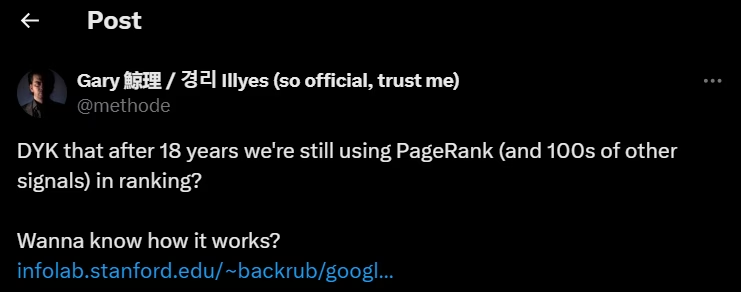
Many from the SEO community, especially SEO thought leaders like Manick Bhan, experimentally showed that PageRank is still used and centralized in the Google search algorithm. In March 2024, leaked Google search API documents revealed that multiple versions of PageRank are still used internally, including RawPageRank, PageRank2, PageRank_NS (nearest seed), and FirstCoveragePageRank. This March 2024 leak confirmed that PageRank principles remain influential in Google’s current search algorithm.
Google likely keeps PageRank hidden to prevent manipulation, preserve competitive advantage, encourage focus on quality content, and avoid link schemes.
What is the Importance of Google PageRank for SEO?
The importance of PageRank for SEO manifests in 6 critical ways listed below.
- PageRank establishes domain authority by helping Google determine which sites are trustworthy sources within their niche, increasing the likelihood of ranking well for competitive terms.
- PageRank improves indexing efficiency by signaling to Google’s crawlers which pages deserve more frequent attention, resulting in faster indexation of new content.
- PageRank enhances ranking stability by creating a buffer of authority that helps sites maintain positions during algorithm updates and competitive shifts.
- PageRank amplifies on-page optimization by creating a multiplier effect where the same content efforts produce better results on high-PageRank pages compared to low-authority pages.
- PageRank powers internal link effectiveness by providing a mechanism for distributing authority throughout a website’s architecture to priority pages.
- PageRank validates content quality by serving as external confirmation that others find your content valuable enough to link to, aligning with Google’s mission to surface the best information.
Analyzing the link relationships between websites helped Google create a more objective way to evaluate content quality and dramatically improve search results’ relevance. The shift from content self-declaration to peer validation remains the base of modern search, making PageRank’s principles necessary for effective Search Engine Optimization despite the evolution of Google’s algorithm over time.
What are the Factors That Impact Google PageRank in SEO?
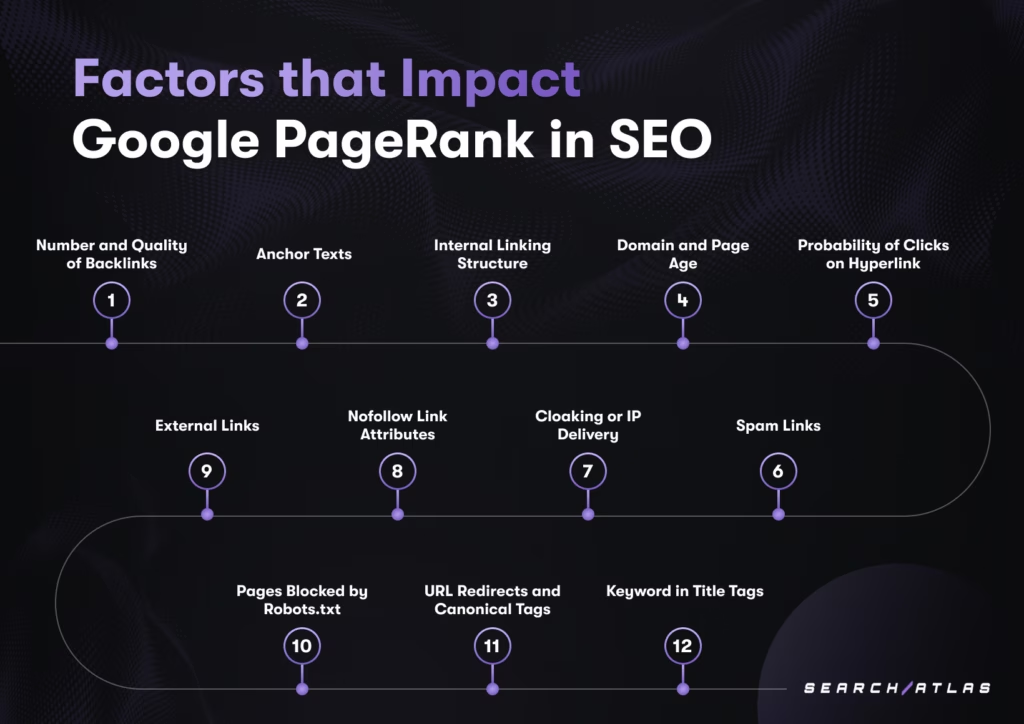
The 12 factors that impact Google PageRank and determine how authority flows to and through your website are listed below.
- Number and Quality of Backlinks. Links from high-authority sites pass more value than those from lesser-known domains, making quality backlinks the foundation of PageRank.
- Anchor Texts. Anchors with diverse text provide contextual signals about your content, helping Google understand relevance while avoiding patterns that might trigger spam filters.
- Internal Linking Structure. The structure of internal linking distributes PageRank throughout your domain, allowing strategic elevation of important pages through proper architecture.
- Domain and Page Age. Domain and page age, or the history of domain establishment, contributes to PageRank accumulation. Older sites with consistent link profiles typically develop stronger authority over time.
- Probability of a Click on the Hyperlink. Links in prominent positions (main content, beginning of articles) pass more PageRank than those hidden in footers or sidebars, as they’re more likely to be clicked by users.
- Spam Links. Links that are low-quality, irrelevant, or manipulative trigger penalties that reduce PageRank or prevent it from being passed. Google actively devalues links from known link farms and spam networks.
- Cloaking or IP Delivery. Cloaking practices risk severe penalties, including PageRank reduction. Showing different content to search engines than to users violates guidelines.
- Nofollow Link Attributes. Links with the rel=”nofollow” attribute traditionally don’t pass PageRank. Google now treats nofollow as a “hint,” not a directive, meaning some authority might still flow through these links.
- External Links. Outlinks to external sites impact your PageRank, with excessive low-quality outbound links potentially diminishing authority. Thoughtful outbound links to reputable sources can signal content quality.
- Pages Blocked by Robots.txt. Content that’s blocked from crawling can’t receive PageRank since Google can’t evaluate it. Important pages need to be accessible to search engine bots.
- URL Redirects and Canonical Tags. URL redirects and canonical tags help consolidate PageRank to the correct versions of your pages instead of diluting it across duplicate content.
- Keywords in Title Tags. Titles with optimized keywords work alongside PageRank, establishing topical relevance that complements link-based authority signals.
How to Increase the PageRank of a Website for SEO?

Increasing the PageRank of a website for SEO requires strategic actions that improve how authority flows through both external and internal links.
The most effective ways to increase your PageRank of a website for SEO are listed below.
1. Build Quality Backlinks to Your Website
Backlinks remain the most direct way to influence PageRank. When authoritative sites link to your pages, Google interprets this as a signal of trust and topical relevance.
The value of a backlink depends on the linking page’s own PageRank, its relevance to your topic, and the context in which the link appears. Link building with editorial content, especially when surrounded by semantically related terms, passes significantly more value than links buried in footers or on unrelated directories.
Search Atlas Site Explorer Tool offers a backlink analysis dashboard, providing visibility into your backlink profile. The Search Atlas Site Explorer Tool helps you identify high-value referring domains, analyze anchor text distribution, and track which pages are attracting the most links. These are all critical insights for developing a PageRank-boosting strategy.
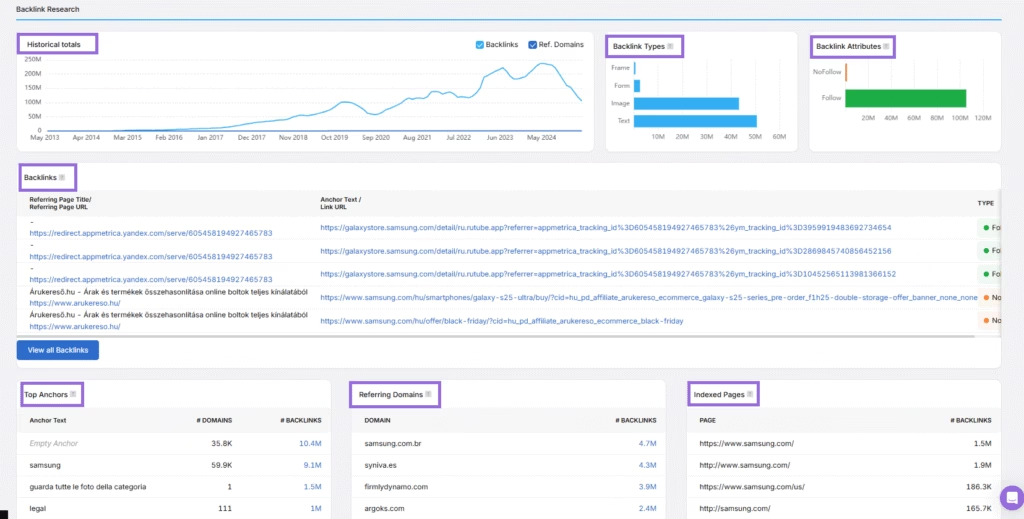
To secure more quality backlinks, prioritize content that deserves to be referenced. In-depth guides, research-backed articles, and interactive tools consistently earn more backlinks than generic blog posts. Promote this content through link building best practices, like digital PR outreach, thought leadership contributions, and niche directories that align with your vertical.
2. Establish Topical Authority Through Content Clusters
Topical authority refers to the perceived depth and breadth of coverage your site offers on a specific subject. Google’s internal PageRank variations, like PageRank_NS (Nearest Seed), favor domains that are tightly connected to “trusted” topic hubs. This means that one way to boost PageRank is to show Google that your content consistently ranks among the best for a given subject.
To do this, you need to create content clusters, a set of related pages (e.g., blog posts, FAQs, use cases) that all link back to a core pillar page. The topical authority structure reinforces internal relevance and helps the central page accumulate and retain PageRank from external links pointing to any part of the cluster.
For instance, a website focused on cold email software could build a cluster around the keyword “cold email outreach.” Supporting content might include articles like “How to avoid the spam folder”, “Best cold email subject lines”, and “Cold email metrics that matter”. Each supporting page links back to the “Cold Email Outreach Guide” pillar, helping it become an authority hub in the eyes of search engines.
The Search Atlas Topical Dominance Tool helps you identify which content silos are weak and where you can develop stronger link relationships internally. The Search Atlas Topical Dominance Tool offers Topic Breakdown and Topic Gap (Ranking) features.
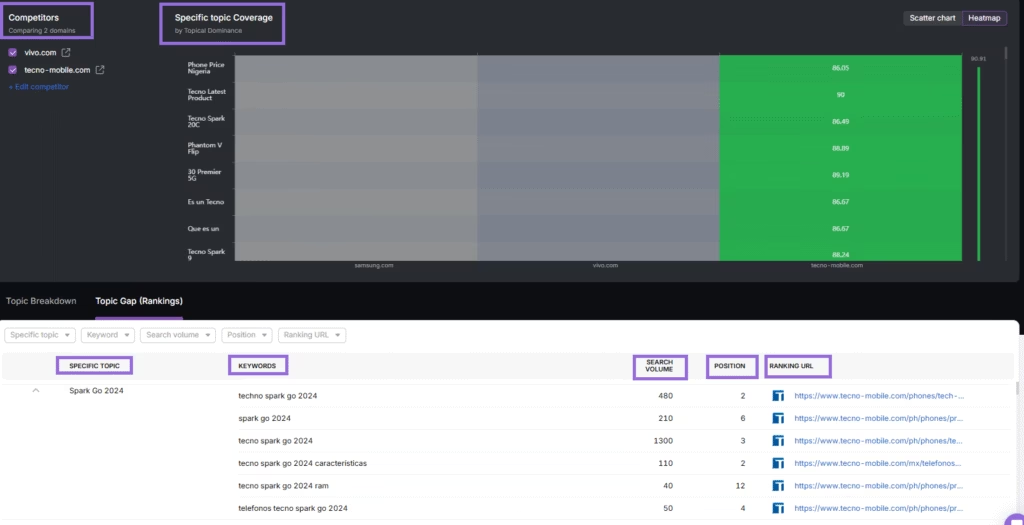
3. Optimize Internal Linking to Control PageRank Flow
Internal linking is your PageRank sculpting tool. While backlinks bring authority into your domain, internal links distribute that authority throughout your content ecosystem. Connecting high-authority pages to conversion-driven or underperforming pages strategically elevates their visibility in search results.
A strong internal linking strategy starts with identifying your most authoritative pages, typically those that rank for competitive keywords or have strong backlink profiles.
From there, create contextual internal links using relevant anchor text that includes your target keywords or entities. Avoid sitewide or footer links. Instead, focus on naturally integrated links within body content.
For example, if your blog post on “email list validation tools” ranks well and has earned strong backlinks, it can pass authority to a new page on “email list warm-up strategies” through a targeted internal link. Over time, this helps your newer content earn ranking power without relying on external links alone.
Search Atlas OTTO SEO Tool automates finding internal linking opportunities and deploying them site-wide. Search Atlas OTTO SEO Tool analyzes semantic connections between pages and suggests internal links based on topical proximity, relevance, and anchor text variety.
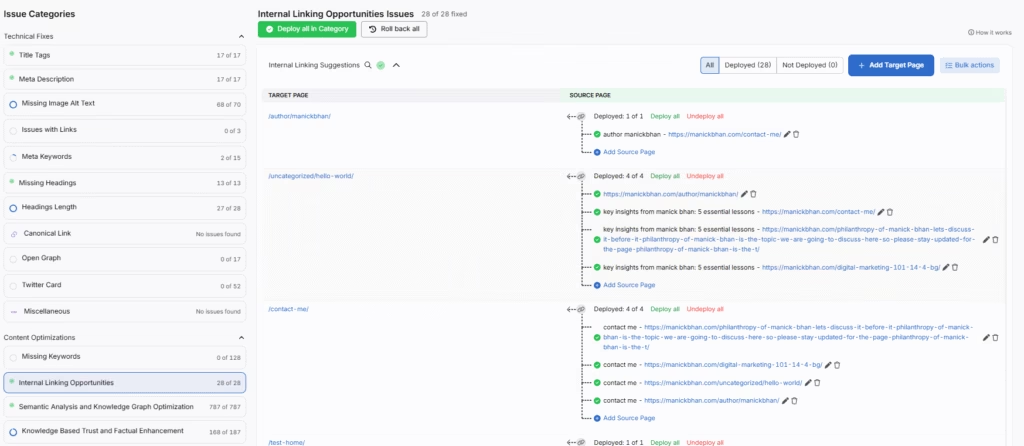
4. Fix Orphaned Pages and Deep Links
Orphaned pages are pages that are not linked to from any other page of your website. Orphaned pages are invisible in your site’s internal link graph, and invisible pages don’t receive PageRank. These pages often struggle to get crawled, indexed, or ranked.
Use tools like the Search Atlas Site Explorer Tool to locate orphaned or deeply buried pages. Once identified with the Search Atlas Site Explorer Tool, integrate orphaned pages into relevant content clusters. If a page is worth keeping, it’s worth linking to.

The same applies to deep links or pages that are more than four clicks from the homepage. These receive significantly less link equity, even with multiple backlinks, because crawl frequency and link flow diminish with depth.
5. Use Canonical Tags and Nofollow Links Strategically
Canonical tags and nofollow links are crucial for consolidating PageRank.
When duplicate content or similar content exists across multiple URLs (e.g., /blog/ and /blog/index.html), search engines dilute link equity unless a canonical tag specifies the preferred version.
Likewise, nofollow tags should be applied to links that don’t require PageRank transfer, such as login pages, privacy policies, or sponsored links. Overuse of nofollow can block legitimate authority flow, but proper implementation helps prevent spam and keeps link equity focused on valuable pages.
Use rel=“nofollow” and rel=“ugc” for user-generated content, and always verify that your canonical tags align with your content goals.
6. Avoid Black-Hat Link Tactics and Low-Quality Backlink Sources
Avoiding black-hat link tactics and low-quality backlink sources is crucial because not all backlinks increase PageRank. Google’s algorithm ignores, or worse, penalizes links from manipulative sources like link farms, private blog networks (PBNs), or irrelevant forums. Such links fail to transfer value and trigger manual penalties.
Focus on earning links, not buying them from shady link providers. Build partnerships with other site owners, offer value through guest contributions, or repurpose original research to become a citation source in your industry.
If you’ve inherited toxic backlinks or previously purchased low-quality links, use the “Disavow links to your site” feature within the Google Search Console (GSC) sparingly to signal Google that you do not endorse these links.
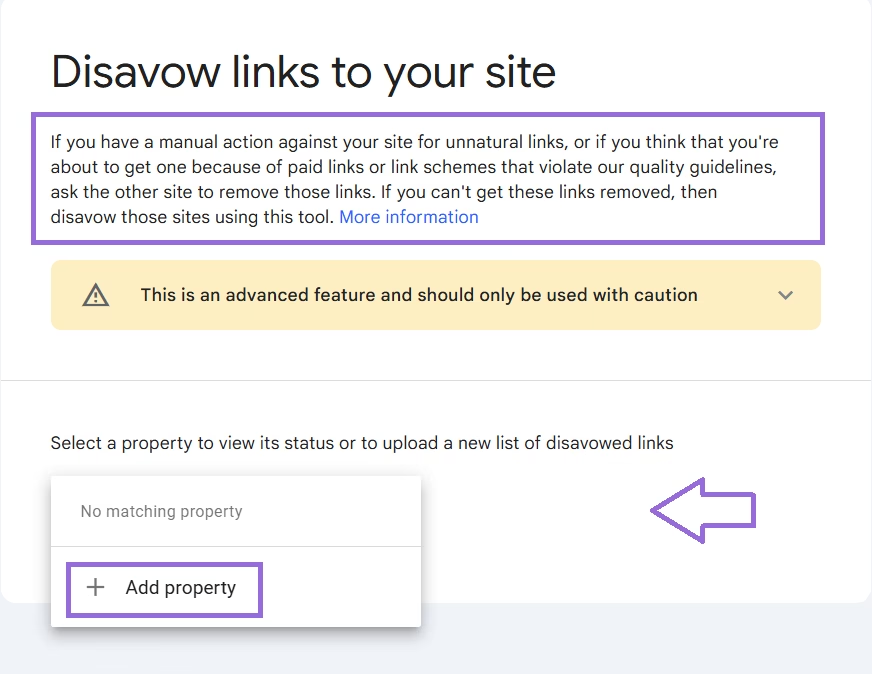
What is a PageRank for a Webpage?
PageRank for a webpage represents its relative importance and authority within the web’s extensive network of interconnected pages. Unlike domain-level metrics, PageRank is calculated separately for each individual page, meaning different pages on the same website can have significantly different PageRank values based on their unique link profiles.
The PageRank of a webpage is determined by analyzing the elements below.
- Direct inbound links. Links pointing directly to the specific page from other websites.
- Internal links. Links from other pages within the same website.
- The authority of linking pages. Links from high-PageRank pages pass more value.
- The number of outbound links on referring pages. PageRank passed is divided among all links on the source page.
PageRank flows through your website in a distributed manner. Typically, a homepage receives the most external links and therefore has the highest PageRank on a site. From there, internal linking determines how that authority is distributed to other pages. Pages that are directly linked from the homepage generally receive more PageRank than those buried deeper in the site structure.
This page-specific nature of PageRank explains why sometimes a new page on an established domain can rank quickly (benefiting from the site’s overall authority), while other times it struggles (if it doesn’t receive sufficient internal linking or direct external links).
Understanding PageRank at the page level helps with strategic decisions outlined below.
- Which pages should link to your most important content?
- Where to place new content in your site architecture?
- Which pages deserve additional link-building efforts?
- How to structure internal linking to maximize the flow of PageRank to priority pages?
You can make more targeted optimization decisions that improve rankings for your most valuable pages by viewing PageRank as a page-specific attribute instead of a domain-wide measure.
What is the Best Alternative to Google’s PageRank Metric?
The best alternative to Google’s PageRank metric is Search Atlas’s Domain Power (DP) score. Domain Power measures website authority based on how Google actually evaluates sites today, not just backlink counts.
Domain Power analyzes real performance data, unlike PageRank and other metrics like Domain Authority (DA) or Domain Rating (DR) that can be manipulated through artificial link building. Search Atlas Domain Power combines organic traffic metrics and ranking keywords to provide a realistic assessment of a domain’s true authority and search visibility.
Domain Power was created after extensive research into leaked Google API documentation, revealing that Google prioritizes relevance and performance over raw link numbers when evaluating domains. The metric considers factors Google values, such as content quality, topical expertise, and genuine user engagement patterns.
Search Atlas built Domain Power with a clear scoring system: 65-100 for major authority sites with massive traffic (like Google at 100, Forbes at 83); 35-65 for established niche leaders with strong relevance; and 0-35 for growing sites still building influence.
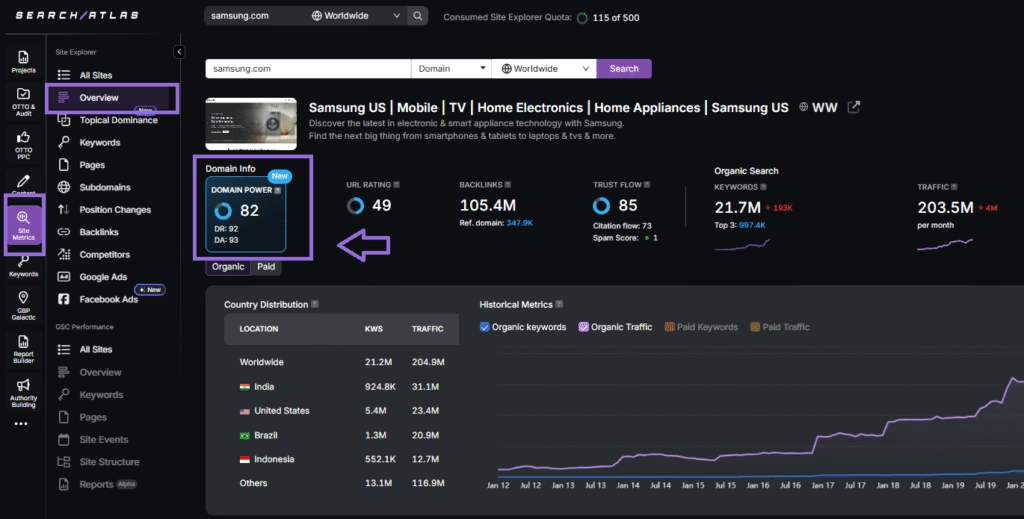
You can access Domain Power through the Search Atlas Site Explorer Tool, which lets you analyze individual websites or bulk-check up to 5,000 domains simultaneously.
For SEO professionals looking to build authority the way Google measures it, Search Atlas Domain Power represents the most accurate alternative to the original PageRank metric, delivering insights that align with how modern search algorithms evaluate website quality and relevance.
How to Check Google PageRank for Keywords?
Checking Google PageRank for keywords is no longer possible directly since Google removed the public PageRank display in 2016. You can still assess the relative authority of pages ranking for specific keywords using alternative methods and tools.
To evaluate the authority of pages ranking for your target keywords, use the Search Atlas Site Explorer Tool, which provides data on search volume, difficulty, and the authority of currently ranking pages.
Compare authority differences with Search Atlas’s Keyword Gap Analysis Tool by analyzing how your site’s authority metrics stack up against competitors’ rankings for your target keywords. The Search Atlas Keyword Gap Analysis Tool helps identify authority gaps preventing you from outranking competitors.
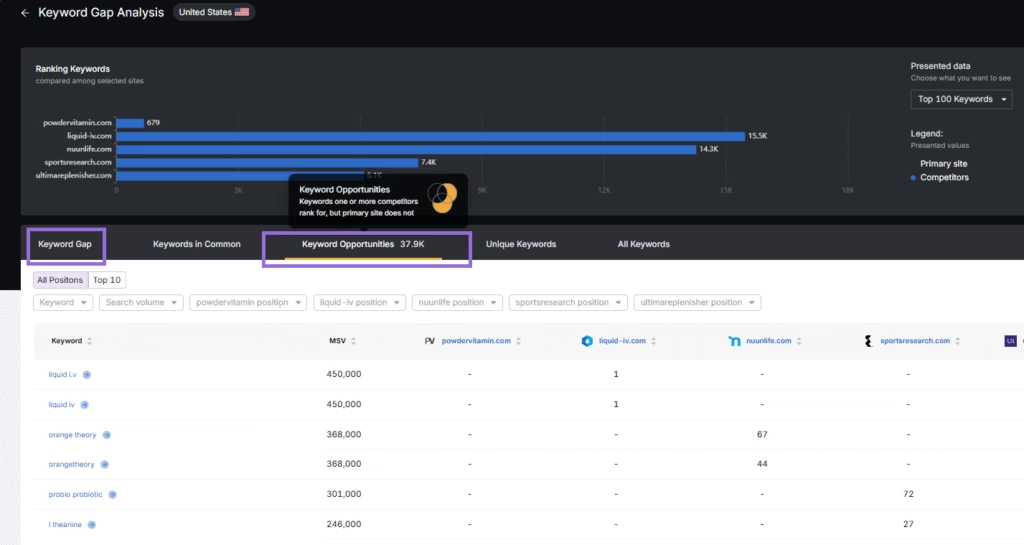
Additionally, you can look at SERP features to pinpoint which pages earn featured snippets, knowledge panels, or top positions for your target keywords. Pages with strong PageRank typically secure these premium positions.
While dedicated Google PageRank checkers for keywords no longer exist, these approaches provide practical insights into the authority needed to rank for specific keywords, helping you prioritize your SEO efforts based on your current position relative to competitors.
Can PageRank be Tracked?
No, PageRank itself cannot be directly tracked since Google no longer publicly displays PageRank scores and has removed the Toolbar PageRank tracker feature. While the algorithm continues to operate internally at Google, the specific PageRank values are kept private and inaccessible to webmasters and SEO professionals.
What to Know About PageRank Besides Click Depth?
PageRank evaluates the entire link ecosystem, not just the internal navigation structure. While click depth measures navigational accessibility within a site, PageRank analyzes the web’s interconnected nature through link relationships.
PageRank considers link relevance, authority distribution, and natural growth patterns that click depth metrics cannot capture. A page buried deep in site architecture may still achieve high PageRank if it attracts quality external links, demonstrating how PageRank transcends simple structural measurements.
Understanding the distinction between PageRank and click depth helps SEO professionals develop strategies that optimize internal navigation and external authority building for maximum visibility.
What to Know About PageRank Besides Domain Authority?
PageRank differs fundamentally from Domain Authority by operating at the page level rather than evaluating entire domains. Google’s PageRank algorithm assigns authority to individual URLs based on their specific link profiles, allowing different pages within the same domain to hold varying levels of importance.
Unlike Domain Authority, which provides an aggregate score, PageRank flows dynamically through links, creating complex authority patterns unique to each webpage. PageRank serves as Google’s native ranking signal, while Domain Authority remains a third-party metric attempting to approximate search performance.
The page-specific method enables more precise optimization targeting high-value content instead of broad domain-level improvements.
What to Know About PageRank Besides Backlinks?
PageRank incorporates sophisticated elements that include backlink counts, but also link quality assessment, relevance evaluation, and manipulation detection. The PageRank algorithm analyzes backlink context, examining surrounding content to determine topical relevance instead of just counting references.
PageRank considers temporal factors, giving different weight to established links versus newly acquired ones, and evaluates natural growth patterns versus artificial link building. Modern PageRank implementation likely incorporates user engagement signals that validate or modify authority based on how visitors interact with content after following links.
Nuanced assessments create an authority measurement system that values quality over quantity of backlinks and rewards authentic endorsements, not manufactured link profiles.
What to Know About PageRank Besides Link Juice?
PageRank operates on principles far more complex than the simplified concept of “link juice” passing from page to page. While link juice metaphorically describes how authority flows through links, PageRank implements sophisticated mathematical calculations to determine how this authority distribution occurs.
Unlike basic link juice models that suggest equal distribution, PageRank considers factors like total outbound links on a page, creating a weighted distribution where pages with fewer outbound links pass more concentrated authority per link. PageRank evaluates circular linking patterns and authority redistribution across the entire web graph, calculating multiple iterations until reaching equilibrium, nuances that basic link juice concepts fail to capture.



